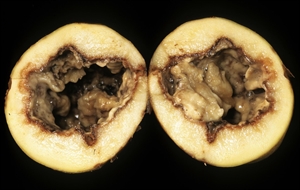Bacterial soft rot
Pacific Pests, Pathogens and Weeds - Online edition
Pacific Pests, Pathogens & Weeds
Potato soft rot (296)
Pectobacterium carotovorum subsp. carotovorum (previously, Erwinia carotovora subsp. carotovora). There are other, related, bacteria species causing stem and tuber rots in potato, most importantly 'black leg' caused by Pectobacterium atrisepticum, and Erwinia chrysanthemi (renamed Dickeya chrysanthemi) causing tuber rots, particularly in tropical countries (see Fact Sheet no. 179).
Wherever potatoes are grown in subtropical, tropical or temperate countries. It has been recorded as Erwinia carotovora subsp. carotovora in stems and tubers of potato in Australia, Fiji, and Papua New Guinea. It has also been recorded from cabbage, carrot, cauliflower, and watermelon in Fiji, and in taro from Solomon Islands (see Fact Sheet no. 179).
Very wide; apart from potato, the bacterium has been recorded from brassicas, capsicum, carrot, edible aroids and other root crops, onion, tomato, and many more, as well as ornamentals.
A common soil bacterium is the cause of the damage. It is often found on the surface of potatoes at harvest, especially in the lenticels (the pits on the tuber where gases are exchanged).
A variety of symptoms occur: (i) soft rots in the 'seed' or planting piece, at lenticels, wounds or where tubers are attached to underground stems. Tuber rots are brown, soft and surrounded by a black margin (Photo 1). Rots also destroy the sprouts as they grow, leaving gaps in the stand; (ii) rots called 'aerial black leg' occur on the stems aboveground, resulting in them falling over. Usually, this symptom comes late in the season, associated with wet weather, and is not common; and (iii) wet soft rots occur in storage, starting at lenticels and wounds if temperatures and humidity are high; these have a foul smell when invaded by other types of bacteria.
Short distance spread occurs as the seed piece breaks down and the bacteria reach the daughter tubers in ground water. Spread over long distances is with the trade in tubers for the fresh market and seed. Rots can be severe in storage if tubers are washed beforehand and the water is contaminated with bacteria. Further spread can occur in storage by tuber-to-tuber contact. Survival occurs in the soil and in stored tubers.
This is an important disease affecting plants in the field and in storage. It is estimated, for instance, that 80% of the stem and tuber soft rots in North America are caused by this bacterium. Depending on the conditions in storage, losses can reach 100%, and are more common in tropical countries where conditions of storage are often less than ideal.
Look for gaps in the stand indicating seed piece rot. Near the time of maturity look for stems with aerial black leg causing plants to wilt. Look for soft rots at harvest around lenticels or at wounds, and monitor tubers in storage for outbreaks of soft rot. Commercial tests exist so that the risk of bacterial soft rot can be predicted for tubers entering storage.
CULTURAL CONTROL
Before harvest:
- Choose seed carefully, preferably healthy seed certified by government agencies.
- Clean equipment used for cutting seed potatoes for planting; if tuber rots are found sterilise knives and cutting surfaces with undiluted bleach.
- Avoid planting fields or parts of fields where waterlogging occurs, or improve drainage by planting on raised beds with adequate border drains.
During growth:
- If using irrigation. delay until plants have emerged and are growing healthily.
- Do not apply excessive amounts of nitrogen fertilizer, otherwise it will increase foliage, which in turn will increase humidity within crops, and the amount of disease.
- Harvest when the vines are dead (7-10 days later); this delay allows the skin to mature.
- Do not harvest when the soil is wet.
- Take care when harvesting to avoid wounds, which allow bacteria to enter tubers.
After harvest:
- Keep stored tubers at 12-15°C for 1-2 weeks for curing after harvest, and then below 10°C in well-ventilated stores.
- Do not wash tubers before storage.
RESISTANT VARIETIES
None recommended.
CHEMICAL CONTROL
None recommended for either the growing crop or the stored tubers.
AUTHOR Grahame Jackson
Information from Diseases of vegetable crops in Australia (2010). Editors, Denis Persley, et al. CSIRO Publishing; and DPI&RD (2017) Soft rot diseases of potatoes. Agriculture and Food. Government of Western Australia. (https://www.agric.wa.gov.au/potatoes/soft-rot-diseases-potatoes); and Reviewing best practices for potato soft rot and blackleg (2019) AUSVEG. (https://ausveg.com.au/articles/reviewing-best-practice-for-potato-soft-rot-and-blackleg/); and from Charkowski A et al. (2020) Bacterial diseases of potato. In: Campos H, Ortiz, O (eds.), The potato crop. (https://www.potatopro.com/sites/default/files/potato-crop-book-chapter-10-bacterial-diseases-of-potato.pdf). Photo 1 Gerald Holmes, California Polytechnic State University at San Luis Obispo, Bugwood.org.
Produced with support from the Australian Centre for International Agricultural Research under project PC/2010/090: Strengthening integrated crop management research in the Pacific Islands in support of sustainable intensification of high-value crop production, implemented by the University of Queensland and the Secretariat of the Pacific Community.




